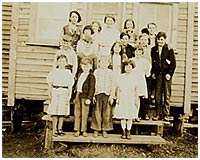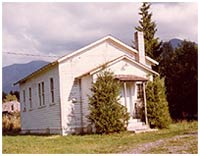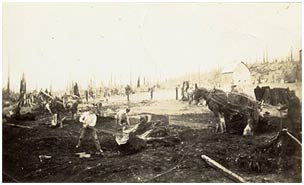
Three important features mark the Columbia Valley. The first is the Canada/United States border that runs through the Valley and over the mountains between Canada and the United States. The second is a collection of four old barns located close to this border, all built around 1900. The third is the network of roads that begin at Lindell Beach and circle Columbia Valley, ending up back at Lindell Beach.
In 1887, when the first families began arriving in Columbia Valley many believed that they were settling in the United States. The border, laid out in 1859/60 by the Royal Engineers, was overgrown and not obvious to these families. Access to the Columbia Valley was via Maple Falls, Washington, a booming logging and mining town, through which Columbia Valley residents received supplies and mail. Sometime around 1905/06 the border was resurveyed and residents confirmed that they were in Canada, not the United States. Poor roads meant that Columbia Valley residents remained oriented to the United States until the Second World War, when access to the United States was greatly restricted. Today, along Henderson Road, which parallels the border, it remains possible to stop at a border monument and circling the monument pass in and out of the United States.
The Jarabeks, Minnicks, Kosikers and Dorkos are the local residents who built the large cedar barns. Their styles are similar, locally split cedar boards, with cedar shake roofs. Long straight beams extend the length of the barns and each features a peaked roof, flaring from the centre to the low side walls. Inside are large haylofts with milking parlors found adjacent to the side walls. All of the barns, circa 1900, are in remarkably wonderful condition. The Jarabek and Minnick barns are located on Henderson Road. The Kosiker and Dorko barns are located on Maple Falls Road.
In 1916, a road, more accurately described as a cart path, was built beside Cultus Lake, connecting Columbia Valley to Chilliwack. However there were times when this road was impassable and residents continued to travel to the United States for supplies. In 1956 this road was improved substantially, giving year round access to Chilliwack.
Other roads in Columbia Valley date to the 1920s when the Campbell River Logging Company began large-scale railroad logging in the Valley. Before then small mill operations used the abundant forest resources. The Campbell River Logging Company had several logging camps located in the Valley, segregated by race. Camps for Japanese and East Indian workers were located near Henderson Road. When the company pulled out of the area around 1930, the former rail beds were converted into roads. Most of the roads in Columbia Valley date to this era.
Old tree stumps still dot the landscape of Columbia Valley. The barns, roads and border are unique features that define the community. Anchoring all this are about 370 people, the current population of the Valley, living on about 3,000 acres of land. Local residents are extremely proud and conscious of the past and recognize the unique features that define the Columbia Valley.
Cheam has remained primarily an agricultural community although urban development is encroaching.

Group portrait of Columbia Valley school class, ca. 1930. P7947

Colour photo showing the Columbia Valley school as it appeared in 1977. P7948.

Group of men clearing site for the Columbia Valley School. P7946.

The Minnick barn in the Columbia Valley was one of four cedar plank barns built in the early 1900s by local residents. Ron Denman photo, 1999.